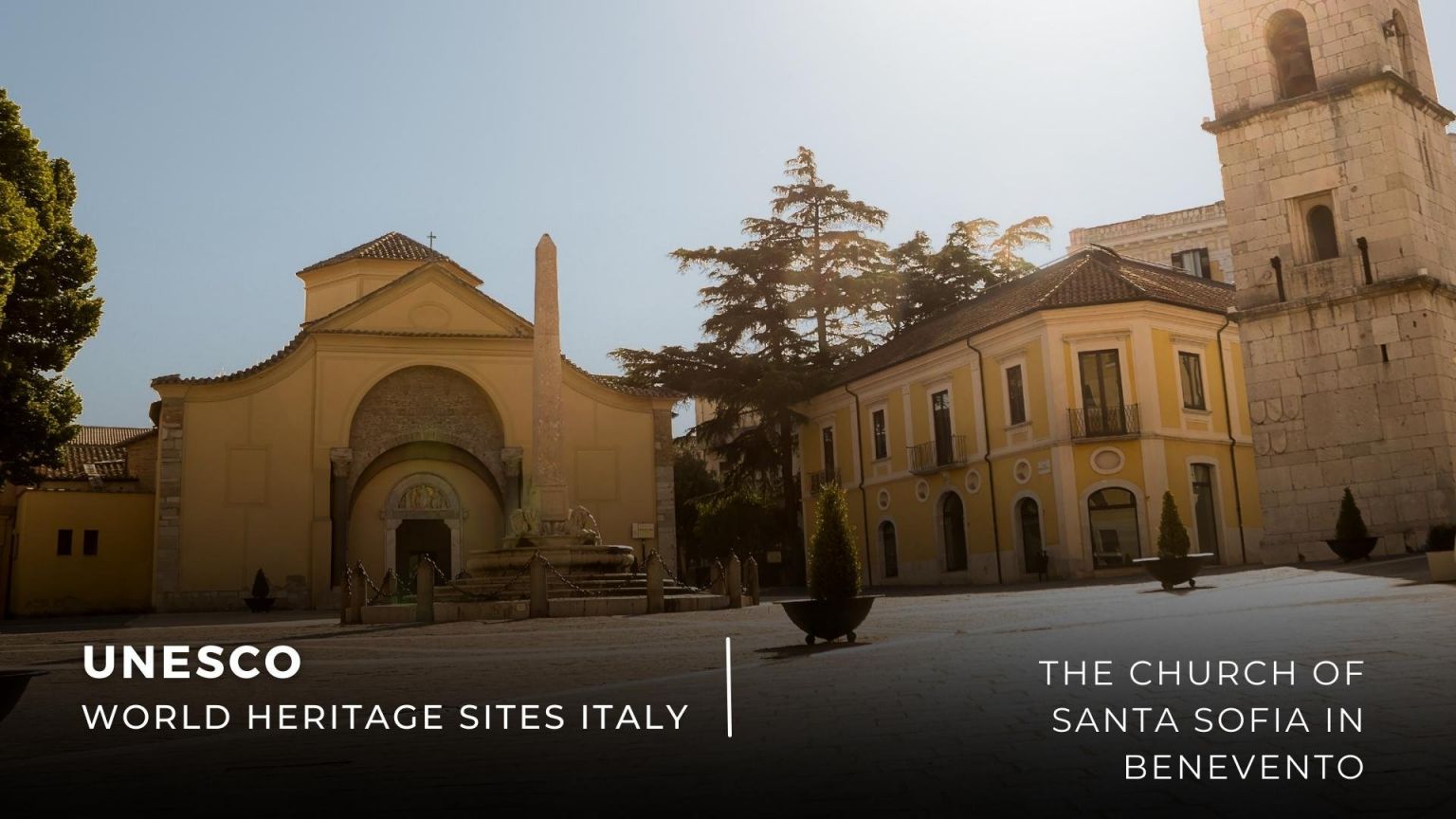A UNESCO World Heritage Site since 2011, the church of Santa Sofia is the stop you still don't know you need to make on your next holiday.
To find it, you'll have to travel to Benevento, an hour away from Naples. It's not something you encounter on the main travel routes of those coming to Campania. Most are seduced by the sparkling Amalfi Coast and Capri or attracted by the historical echoes of Pompeii and Herculaneum.
Yet, if you are curious enough to set aside the traditional tourist trails, you'll find this ancient inland town beautiful, seductive and pleasantly quiet. Here's why.

The Church of Santa Sofia in Benevento, a UNESCO World Heritage Site
The church of Santa Sofia in Benevento is one of the buildings (monasteries, temples and fortresses) scattered throughout Italy dating back to the years of the Longobard domination, between the 6th and 8th centuries. It's a circuit of impressive architecture, now a UNESCO World Heritage Site, symbolic of Longobards' power, art and culture.
The traces of this legacy are also present in southern Italy, where Benevento used to be a flourishing and 'frontier' duchy (it was the southernmost part of the kingdom).
The monumental complex of Santa Sofia overlooks Piazza Matteotti, a small and elegant corner placed along Corso Garibaldi.
The church is modest in size— its circumference is less than 24 metres. Still, it stands out for the originality of its plan, a novelty for the European architectural style of the time. Its particular conformation closely resembles the larger and more famous Hagia Sophia in Istanbul.
It seems that Paul Deacon, one of the leading historians of the Middle Ages, intended to dedicate the edifice to Divine Wisdom as a tribute not only to the highest form of knowledge but to the Justinian Church of Constantinople.
Once you enter inside and leave behind its sober and linear façade, you'll surely notice the geometries designing the interior spaces in a play of perspectives, shapes and dimensions. Its theatrical look leaves every visitor astonished.
The church preserves the columns of the ancient temple of Isis, a Roman place of worship. Of all the frescoes that originally embellished the walls, only the ones on the two side apses are now visible.
In addition to the church of Santa Sofia, the Benevento complex includes the adjoining former monastery, an 11th-century bell tower and the fountain in the middle of the square. Oh, and there is also an enchanting cloister. This chiostro was rebuilt in the 12th century after the earthquake of 986 and shows a perfect and harmonious blend of Western and Eastern elements, Christian motifs, classical art and imaginative images.
Today, the abbey is home to three of the four departments of the Museo del Sannio, with works and artefacts that retrace the long history (the oldest finds date back to prehistoric times) of the Samnite civilisation.
The Longobards in Italy and the Places of the Power, a UNESCO World Heritage Site
The UNESCO itinerary "Longobard in Italy. Places of the Power" consists of seven sites crisscrossing Italy from north to south. Each depicts the prestige of the Longobard domination and the transition from Antiquity to the Middle Ages. Each one represents with its specific characteristics an extraordinary artistic, cultural and architectural synthesis between the Roman, Germanic, Byzantine, Hellenistic and Middle Eastern worlds.
Furthermore, the Longobards had a remarkable ascendancy on the cultural and spiritual structure of European Christendom: they contributed to the strengthening of the monastic orders, were forerunners for religious pilgrimages and were instrumental in the preservation and transmission of classical works of literature, science, architecture, history and law. The UNESCO serial site bears monumental witness to this legacy.
The church of Santa Sofia was the most important place of worship in the Longobard kingdom and, in particular, of the so-called Longobardia Minor, the royal territories in central and southern Italy.
In its entirety, the UNESCO site includes:
- The Longobard temple of Cividale del Friuli, an impressive and somewhat mysterious building. Uncertain are its origins and use. Even its name, tempietto (little temple), seems incorrect when analysing its structure. The interior retains some of the original decorations, stuccoes and enchanting frescoes.
- The monastic complex of San Salvatore and Santa Giulia in Brescia contains some of the best-preserved decorations from the early Middle Ages.
- The castrum of Castelseprio-Torba, an archaeological park in the province of Varese, with the ruins of an ancient fortified settlement used as a women's monastery in the Longobard era.
- The small temple of Clitunno in Campello, Umbria, a small temple built by reusing the remains of an earlier cult building and whose style is reminiscent of classical Roman architecture.
- The Basilica of San Salvatore in Spoleto is a masterpiece of architecture. Here, too, we are faced with a skilful homage to Roman art. And if the interior is now bare of the decorations that once covered it, it still preserves a haughty and original monumentality.
- The Sanctuary of San Michele in Monte Sant'Angelo is one of the main pilgrimage routes of Christianity. This temple in the province of Foggia is, together with the Sacra di San Michele in Piedmont and the Abbey of Mont Saint-Michel in France, one of the main places of worship dedicated to the Archangel in Europe.
Let's discover the city of the church of Santa Sofia in Benevento UNESCO World Heritage Site
In addition to its UNESCO heritage site, Benevento boasts many highlights: galleries and churches that make it an authentic open-air museum, an intriguing culinary panorama, and the lovely villages in the Valle del Sannio. All seasoned with stories and legends that will spice up the trip with a sprinkling of mystery.
After all, Benevento is the city of witches, le janare. Strega (witch in Italian) is also the name of the local liquor prepared with a secret recipe including 70 different herbs.
Forget the excessive crowds that sometimes make irritating even the most celebrated attraction. Benevento's outstanding artistic and cultural heritage is still for the few. Indeed, a destination for true connoisseurs.
Looking for what to do and see in Benevento? Start in the most classic way: go for a stroll in the historic centre. You don't need a specific destination.
Walking along Corso Garibaldi, with its parade of bars, restaurants, and shops, you will come across the 12th-century Cathedral and its diocesan museum; the Arch of Trajan, one of the best arches of classical antiquity; and the church of Santa Sofia, which we are getting to know better.
You will love the area around the Conservatorio, inlaid with narrow streets with a distinctive, particular atmosphere.
Reach the convent of San Domenico and its hortus conclusus, an enigmatic art installation by Domenico Paladino.
Visit the Egyptian section of the Museo del Sannio, where you'll admire the remains of the Temple of Isis, one of the most important temples of the Roman Empire. Emperor Domitian made it built with materials imported from Egypt.
The majestic Roman Theatre is a splendid building dating back to the 2nd century AD and resurfaced following excavations in 1920. It's counted among the world's most beautiful and magnificent ancient theatres. During the summer, it becomes an exceptional setting for the opera festival.
About the author
Written on 09/01/2023




Lorena Calise
The church of Santa Sofia in Benevento is a fascinating UNESCO Heritage Site part of the serial site 'Longobards in Italy. Places of the power'.